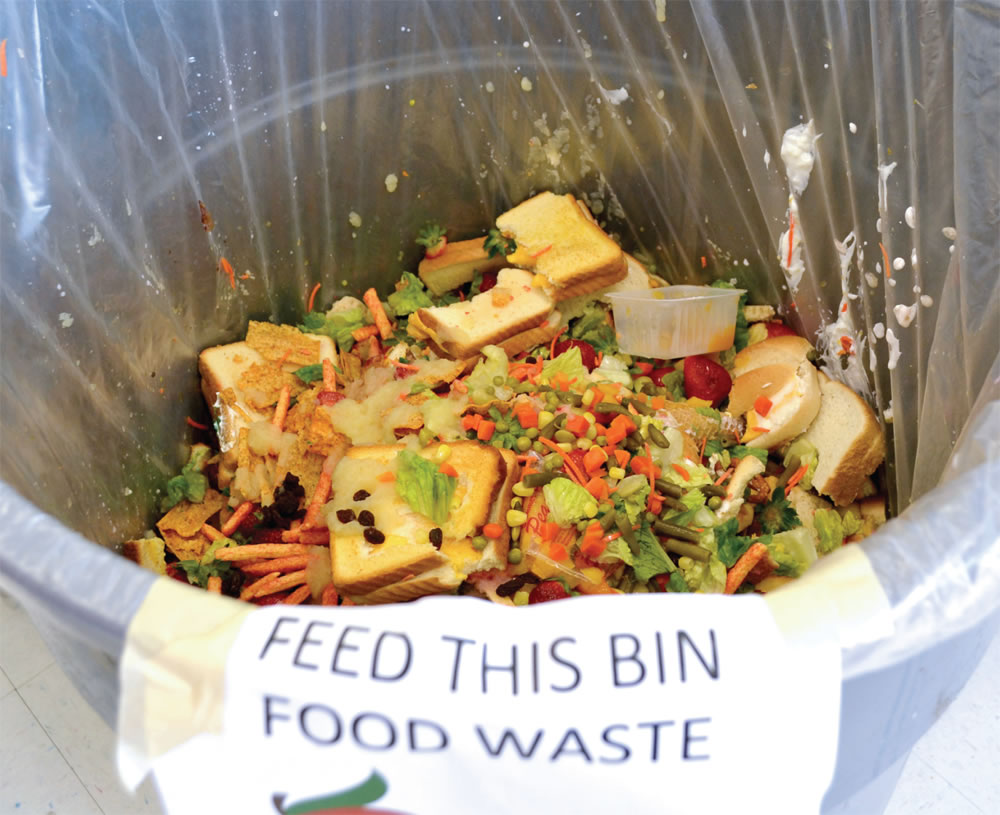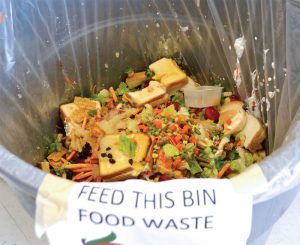The Iowa Waste Reduction Center’s K-12 audits and training, and the Environmental Research and Education Foundation’s SCrAP program, provide critical tools to reduce food waste.
Marsha W. Johnston
BioCycle November 2017
Recognizing the need to build awareness and implement programs at K-12 schools, the Environmental Research and Education Foundation (EREF), in collaboration with the School Nutrition Foundation, SNA’s philanthropic sister organization, and Keep America Beautiful, created the School Cafeteria Discards Assessment Project (SCrAP). The project was founded to begin establishing a baseline of national data on food waste management in K-12 schools.
SCrAP Measurement
SCrAP has three levels of participation — purple, blue and gold, in ascending order of complexity. All levels require a school representative to answer a questionnaire designed to document cafeteria policies and practices as they relate to waste generation. The questionnaire asks for details on the school’s cafeteria set-up, type of waste management service, what kind of lunches (e.g. how many reduced-price), composting availability, recycling activity, and landfill use, explains Bryan Staley, EREF president.
Purple level involves answering the questionnaire. Blue and gold level participation are for schools that want to measure their waste. The school must set up different bins (compostables, recyclables, landfill, unused or uneaten food), weigh the contents, record the data, and take pictures to understand their contamination data. Schools submit the data to EREF.
Blue level participants conduct measurements 3 to 5 times during the school year. Gold level SCrAP participation requires conducting 6 to 10 measurements throughout the school year, providing EREF more data with which to correlate weights with certain menus, notes Staley, such as if less food waste occurs on pizza day than on taco day. “Then the School Nutrition Foundation can use that data to tell its members that ‘maybe we can devise a menu that kids will eat more of,’” he explains.
During the 2016-17 school year, of the 171 schools of all grade levels enrolled in SCrAP, 86 submitted data to EREF. Those 86 blue and gold level schools, comprised 33 elementary schools, 6 middle schools, 21 high schools and 26 mixed-level schools. Among them, about 91 percent already had recycling. Even more surprising, says Staley, 16 percent had backyard or on-site garden composting and 9 percent collect organics for off-site processing, resulting in one-quarter of the schools that were “already doing something with their food waste.” Finally, 13 percent of the participating schools regularly tracked their waste quantities, including food. For its second year of operation, SCrAP has enrolled nearly 250 schools, as nearly all of last year’s schools elected to continue and additional schools signed up. EREF has a goal of 400 schools for 2017-18 school year.

Food waste audits benefit when school administrators are keenly interested in strategies to reduce food waste in their K-12 schools. Also helpful to audits are buckets used to measure discarded food (right). Photos courtesy of EREF
Food Waste Audits
EREF routinely asks blue and gold SCrAP participants if they would also like a more detailed food waste audit. Of the 86 blue and gold schools participating last year, 73 schools indicated an interest. The audits were conducted via a collaboration between the World Wildlife Fund (WWF) and its independent contractor, University of Arkansas food policy researcher Melissa Terry. Terry shepherded schools through the audit using the new U.S. Environmental Protection Agency (EPA) Student Food Waste Audit Guide that she coauthored with Stephen Sturdivant (EPA Region 6), and Jimmy Nguyen (USDA’s Food and Nutrition Service.)
Those blue and gold schools could also sign up to receive a pilot lesson plan developed by the World Wildlife Fund (WWF), which highlights the impact food production has on our environment and biodiversity (see sidebar). WWF also provided posters and “Food Waste Warrior” bracelets.
IWRC’s Trent, who has conducted audits in rural schools since 2013, says a successful food waste audit is one where the school administration is “really interested in implementing strategies and techniques to reduce food waste.” In recruiting schools, she typically first approaches nutrition directors, “because they are more open to [food] waste audits,” but they must have the support of the principal and administration to implement strategies to prevent and reduce food waste.
Getting a school administration on board with an audit team can be facilitated by presenting a “Student Food Conservation Action Plan” to the school board. This plan might include:
• Education plan for teachers on “what makes a plate.”
• Education piece for students on not taking more than they can eat beyond the requirement.
• Composting plan, involving either an on-site program, community garden or local composter.
• Plan to “adopt” an animal at a local farm or petting zoo that can consume discarded fruits and vegetables, if no composting is available.
• New signage and separate trash bins dedicated to discarded produce, and a plan to engage janitorial staff to monitor.
• Proposal to change recess time to before lunch, which has been shown to reduce postconsumer cafeteria food waste by as much as 30 percent.
Just as important to successfully teaching students about food waste, adds Trent, is having a surrounding community highly motivated to tackle the problem. She has found that awareness of food waste in rural communities is limited. A lot of rural areas don’t have recycling haulers, much less places to compost.
Engaging cafeteria staff prior to a food waste audit is critical to determining its scope. Before involving students, Trent advises asking school kitchen staff to track their kitchen waste for a week or two, noting the type of food, amount, reason for disposal, and who recorded the waste. Afterwards, staff should meet to analyze the tracking sheets, the top disposed items, and brainstorm ways to reduce them. Maybe they need to make less of a certain item, adjust an unpopular recipe, order smaller quantities more frequently, or check produce when it arrives to make sure it’s fresh. Trent says she gets great enthusiasm from staff for tracking.
On the day of the audit, Trent recommends setting up 5 garbage cans and one 5-gallon bucket in the area where students put their finished lunch waste. Each garbage can is labeled with one type of waste — Recyclables, Compostables, Food Waste, Cold Lunch Waste and Trash (chip bags, condiment packages). The 5-gallon bucket is for liquid waste like milk or juice.
Interestingly, food waste audits nationwide over the last few years have consistently identified the massive quantity of milk that children dump as one of the biggest food waste problems. Milk used to be considered a mandatory nutritional supplement, and most, including cafeteria staff, still believe kids must take it. But, explains Terry of the University of Arkansas, kids in Offer v. Serve school cafeterias no longer have to take milk.
WWF’s Food Policy Director Pete Pearson puts it this way: “Reducing food waste requires shifts not just in behavior but more deeply in our culture. WWF is working with public schools to educate students and teachers about the value of food and strategies for reducing waste. The WWF Food Waste Warrior program aims to promote more sustainable and economical food procurement and service strategies in schools, and to build a culture of respect for food that can help students forge lifelong habits.”
Trent notes that training students to sort their cafeteria waste is the easiest approach. She requests 3 to 5 students as helpers per lunch period. They stand behind the buckets to make sure students are sorting correctly. Kindergarteners can be told to leave their trays on a table for student helpers to sort. Trent’s team asks kids to put any unopened or uneaten food or drink in a separate spot on a table, to showcase food that is prime for recovery and donation.
Taking Action
When providing audit findings to the schools, both the SCrAP and Iowa food waste audit teams highlight strategies to reduce food waste, such as doing a share table, and not forcing kids to take food they don’t want. “We provide resources that allow them to make decisions on how they can minimize the generation of waste as well as manage the waste they do create,” explains Staley. This includes giving information on finding local composters or anaerobic digesters. SCrAP also does some lottery-style drawings during the year that provide schools cash donations to support any program. So far, EREF notes that the monies will be used for compostable trays, possibly a solar panel, composting bins, funding a green team/sustainability club and gym equipment.
Trent uses the U.S. EPA’s WaRM model to calculate the school’s mitigated carbon dioxide emissions (MTC02e), and translates it to an understandable number with the EPA’s Equivalency Calculator. She also looks up disposal costs at the local landfill for their food waste. “I try to touch on the social, environmental, and economic consequences of food waste,” she says.
The strategy schools are most interested in is the share table or knowing where they can donate the food, adds Trent. However, public health policies around establishing K-12 food share tables vary greatly, so schools have to work with local public health departments to facilitate share tables.
Despite the knowledge and insights gained, many schools do not act on audit information. “Some of them seem to just want the data,” she notes. “It’s frustrating to go into a school, do all the work and know that they don’t implement anything, but the awareness and knowledge we create is the first step.”
Marsha W. Johnston is a Contributing Editor at BioCycle and an Editor at Earth Steward Associates in Arlington, VA.











